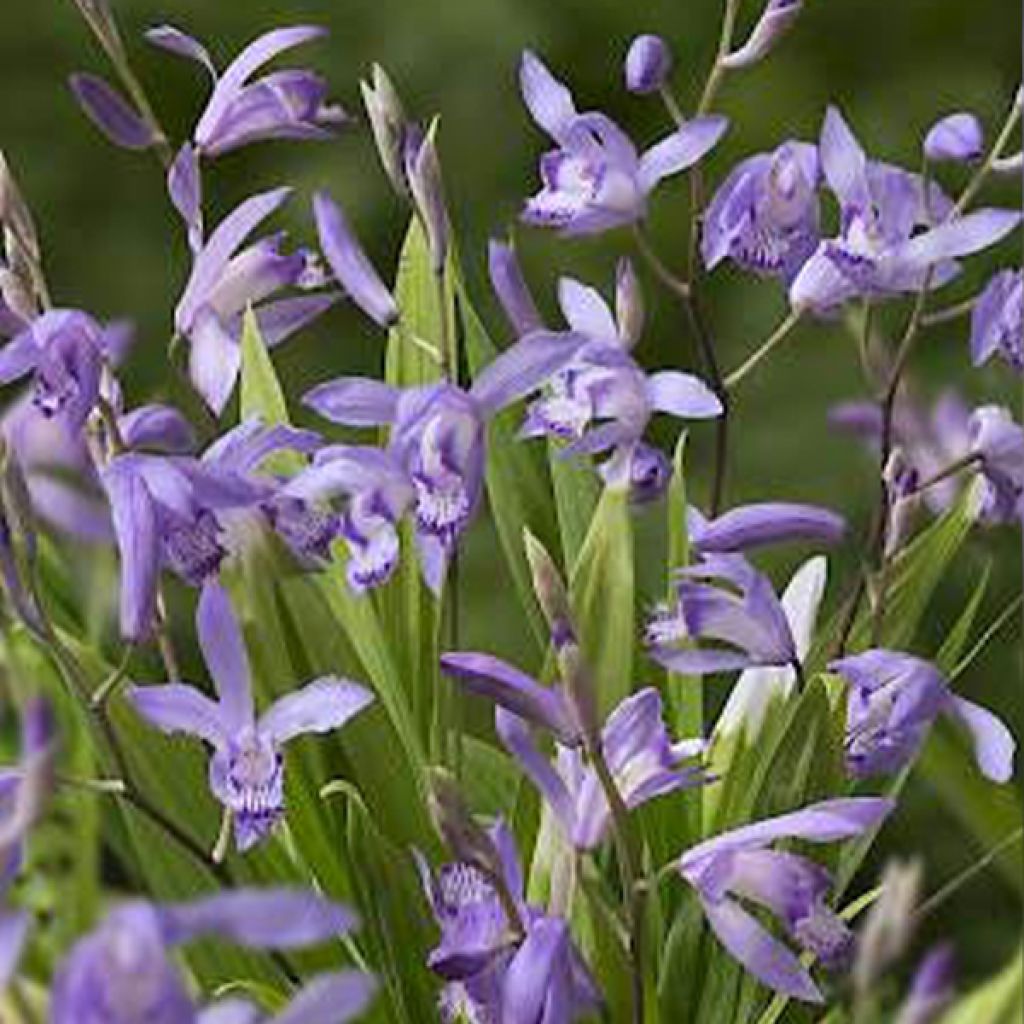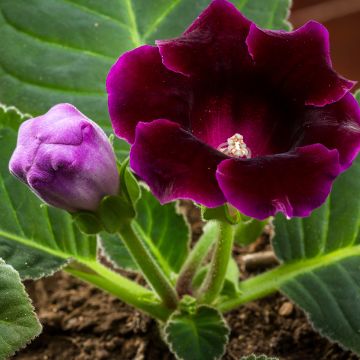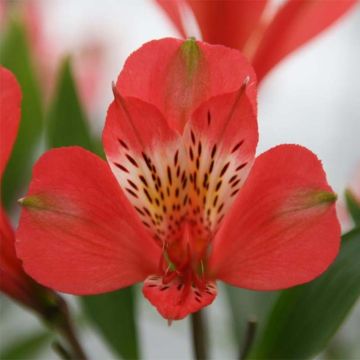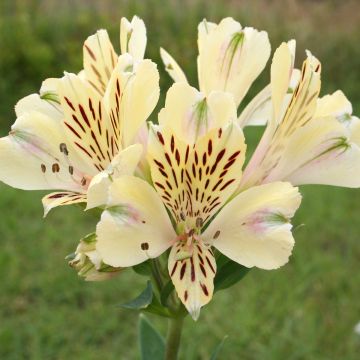

Bletilla striata Blue


Bletilla striata Blue
Bletilla striata Blue
Bletilla striata Blue
Chinese Ground Orchid, Hyacinth Orchid, Hard Ground Orchid
Why not try an alternative variety in stock?
View all →This plant carries a 12 months recovery warranty
More information
We guarantee the quality of our plants for a full growing cycle, and will replace at our expense any plant that fails to recover under normal climatic and planting conditions.
From €5.90 for pickup delivery and €6.90 for home delivery
Express home delivery from €8.90.
Does this plant fit my garden?
Set up your Plantfit profile →
Description
Bletilla striata 'Blue' is a rare variety of hyacinth orchid. It is one of the easiest terrestrial orchids to grow, suitable for gardeners starting their orchid collection. It produces typical flowers, of an intriguing blue colour, on loose clusters of shiny green foliage. It is adapted to a woodland edge environment and likes non-scorching sunlight or partial shade in moist, light, humus-bearing soil.
Bletilla striata 'Blue' belongs to the orchid family. It is native to Japan, where it is also called "Blue Hyacinth Orchid". It grows from semi-buried pseudobulbs, resembling tubers that form a 45 cm long arc. This plant forms a trailing clump from spring onwards, composed of broad, arching, and slightly soft leaves. It produces small, fully open flowers in summer, in June-July, depending on the climate, on stems reaching 60 cm high. The flowers are a true cold blue, slightly lavender. The flower consists of 3 sepals and 3 petals, one of which is called the lip. It is often this floral part that is astonishing in orchids. The lip of 'Blue' is white, spotted with darker blue-violet. The deciduous leaves are medium green, beautifully pleated, up to 30 cm long and 5 to 7 cm wide. The plant produces seeds that seem to produce plants identical to the parent plant.
'Blue', like all other Bletilla striata, is cold-resistant to -20°C and easier to grow than other species, as its planting conditions are less demanding. It requires soil that remains moist, humus-bearing, and well-drained, in protected, bright locations, but sheltered from the scorching sun. Its leaves will disappear due to frost but will regenerate in early spring. The rhizomatous clump will slowly sucker to form beautiful clusters. Plant Bletilla striata 'Blue' in light and moist woodland or even near water features, alongside hostas, ferns, brunneras, or even barrenworts. Bletilla can also be grown in pots to enhance your terraces, in partial shade, but they should be stored indoors during cold climates in winter.
Report an error about the product description
Flowering
Foliage
Plant habit
Botanical data
Bletilla
striata
Blue
Orchidaceae
Chinese Ground Orchid, Hyacinth Orchid, Hard Ground Orchid
Southeast Asia
Other Bletillas or Hyacinth Orchids
Planting and care
Plant Bletilla Blue in a rich, humus-rich, light, airy, and well-drained soil. You can improve the soil in your garden by incorporating compost for perennial plants. For optimal results, add 20% lava stone, which will help maintain good moisture in the summer while ensuring good drainage during the winter. More than intense frost, it is the excess water in winter that proves to be the main enemy of the pseudobulbs.
If the soil in your garden is too compact or clayey, we recommend creating a planting pocket. Dig a hole of about 40 cm cubed, cover the bottom with a layer of drainage (lava stone or fine gravel), and fill it with the mixture indicated above.
Bletilla can also be grown in pots. However, be sure to choose a container that is large enough, with a minimum diameter of 30 to 40 cm, to allow the new shoots to develop on the periphery. Water regularly from April to September, then let your plants rest. In winter, in regions with very harsh cold (-25°C), place your pots in a sheltered, cool (below 5°C), and bright location.
Planting period
Intended location
Care
This item has not been reviewed yet - be the first to leave a review about it.
Bulbs to grow in pots
Haven't found what you were looking for?
Hardiness is the lowest winter temperature a plant can endure without suffering serious damage or even dying. However, hardiness is affected by location (a sheltered area, such as a patio), protection (winter cover) and soil type (hardiness is improved by well-drained soil).

Photo Sharing Terms & Conditions
In order to encourage gardeners to interact and share their experiences, Promesse de fleurs offers various media enabling content to be uploaded onto its Site - in particular via the ‘Photo sharing’ module.
The User agrees to refrain from:
- Posting any content that is illegal, prejudicial, insulting, racist, inciteful to hatred, revisionist, contrary to public decency, that infringes on privacy or on the privacy rights of third parties, in particular the publicity rights of persons and goods, intellectual property rights, or the right to privacy.
- Submitting content on behalf of a third party;
- Impersonate the identity of a third party and/or publish any personal information about a third party;
In general, the User undertakes to refrain from any unethical behaviour.
All Content (in particular text, comments, files, images, photos, videos, creative works, etc.), which may be subject to property or intellectual property rights, image or other private rights, shall remain the property of the User, subject to the limited rights granted by the terms of the licence granted by Promesse de fleurs as stated below. Users are at liberty to publish or not to publish such Content on the Site, notably via the ‘Photo Sharing’ facility, and accept that this Content shall be made public and freely accessible, notably on the Internet.
Users further acknowledge, undertake to have ,and guarantee that they hold all necessary rights and permissions to publish such material on the Site, in particular with regard to the legislation in force pertaining to any privacy, property, intellectual property, image, or contractual rights, or rights of any other nature. By publishing such Content on the Site, Users acknowledge accepting full liability as publishers of the Content within the meaning of the law, and grant Promesse de fleurs, free of charge, an inclusive, worldwide licence for the said Content for the entire duration of its publication, including all reproduction, representation, up/downloading, displaying, performing, transmission, and storage rights.
Users also grant permission for their name to be linked to the Content and accept that this link may not always be made available.
By engaging in posting material, Users consent to their Content becoming automatically accessible on the Internet, in particular on other sites and/or blogs and/or web pages of the Promesse de fleurs site, including in particular social pages and the Promesse de fleurs catalogue.
Users may secure the removal of entrusted content free of charge by issuing a simple request via our contact form.
The flowering period indicated on our website applies to countries and regions located in USDA zone 8 (France, the United Kingdom, Ireland, the Netherlands, etc.)
It will vary according to where you live:
- In zones 9 to 10 (Italy, Spain, Greece, etc.), flowering will occur about 2 to 4 weeks earlier.
- In zones 6 to 7 (Germany, Poland, Slovenia, and lower mountainous regions), flowering will be delayed by 2 to 3 weeks.
- In zone 5 (Central Europe, Scandinavia), blooming will be delayed by 3 to 5 weeks.
In temperate climates, pruning of spring-flowering shrubs (forsythia, spireas, etc.) should be done just after flowering.
Pruning of summer-flowering shrubs (Indian Lilac, Perovskia, etc.) can be done in winter or spring.
In cold regions as well as with frost-sensitive plants, avoid pruning too early when severe frosts may still occur.
The planting period indicated on our website applies to countries and regions located in USDA zone 8 (France, United Kingdom, Ireland, Netherlands).
It will vary according to where you live:
- In Mediterranean zones (Marseille, Madrid, Milan, etc.), autumn and winter are the best planting periods.
- In continental zones (Strasbourg, Munich, Vienna, etc.), delay planting by 2 to 3 weeks in spring and bring it forward by 2 to 4 weeks in autumn.
- In mountainous regions (the Alps, Pyrenees, Carpathians, etc.), it is best to plant in late spring (May-June) or late summer (August-September).
The harvesting period indicated on our website applies to countries and regions in USDA zone 8 (France, England, Ireland, the Netherlands).
In colder areas (Scandinavia, Poland, Austria...) fruit and vegetable harvests are likely to be delayed by 3-4 weeks.
In warmer areas (Italy, Spain, Greece, etc.), harvesting will probably take place earlier, depending on weather conditions.
The sowing periods indicated on our website apply to countries and regions within USDA Zone 8 (France, UK, Ireland, Netherlands).
In colder areas (Scandinavia, Poland, Austria...), delay any outdoor sowing by 3-4 weeks, or sow under glass.
In warmer climes (Italy, Spain, Greece, etc.), bring outdoor sowing forward by a few weeks.
















































